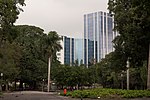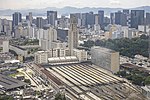Federal University of Rio de Janeiro Faculty of Law

The Federal University of Rio de Janeiro Faculty of Law (Portuguese: Faculdade de Direito da Universidade Federal do Rio de Janeiro (UFRJ)), also known as the National Faculty of Law (Portuguese: Faculdade Nacional de Direito), is a law school located in downtown Rio de Janeiro, Brazil. Founded in 1920 through the merger of two private law schools dating from the 1880s, it is the third oldest law school in Brazil, after the University of São Paulo Faculty of Law and the Federal University of Pernambuco Faculty of Law, both founded in 1827. It is also the largest public law school in Brazil, with an enrollment of around three thousand students. Its alumni include some of the most distinguished legal scholars and public officials of Brazil, and members of the Supreme Court like Lafayette de Andrada (1945–1969), Assunção Galotti (1949–1974), Nélson Hungria (1951–1961), Nunes Leal (1960–1969), Cordeiro Guerra (1974–1986), Moreira Alves (1975–2003), and Marco Aurélio Mello (1990–present). The Faculty is located in the palace once dedicated to the Count of Arcos, in which the Brazilian Senate met from 1826 to 1924.
Excerpt from the Wikipedia article Federal University of Rio de Janeiro Faculty of Law (License: CC BY-SA 3.0, Authors, Images).Federal University of Rio de Janeiro Faculty of Law
Rua Moncorvo Filho, Rio de Janeiro Centro (Zona Central do Rio de Janeiro)
Geographical coordinates (GPS) Address External links Nearby Places Show on map
Geographical coordinates (GPS)
| Latitude | Longitude |
|---|---|
| N -22.9072 ° | E -43.1906 ° |
Address
Faculdade de Direito da UFRJ
Rua Moncorvo Filho 8
20211-340 Rio de Janeiro, Centro (Zona Central do Rio de Janeiro)
Rio de Janeiro, Brazil
Open on Google Maps









